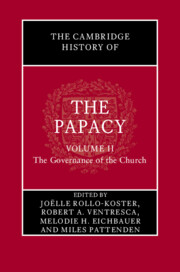Book contents
- The Cambridge History of the Papacy
- The Cambridge History of the Papacy
- Copyright page
- Contents
- Figures
- Tables
- Maps
- Contributors
- General Introduction
- Part I The Pope within the Church
- Part II The Roman Curia
- 6 Putting the Spoke(s) in: Curial Centrality and Local Agency in the Pre-Reformation Church
- 7 The College of Cardinals
- 8 The Secretariat of State
- 9 The Papal Penitentiary
- 10 “Whoever is sent from another”: Legates as Instruments of Papal Government
- 11 Inquisition, Holy Office, and the Congregation for the Doctrine of the Faith
- 12 Nepotism and Roman Micro-Policy
- Part III Canon Law
- Part IV Finance
- Part V Papal States
- Select Bibliography
- Index
6 - Putting the Spoke(s) in: Curial Centrality and Local Agency in the Pre-Reformation Church
from Part II - The Roman Curia
Published online by Cambridge University Press: 28 February 2025
- The Cambridge History of the Papacy
- The Cambridge History of the Papacy
- Copyright page
- Contents
- Figures
- Tables
- Maps
- Contributors
- General Introduction
- Part I The Pope within the Church
- Part II The Roman Curia
- 6 Putting the Spoke(s) in: Curial Centrality and Local Agency in the Pre-Reformation Church
- 7 The College of Cardinals
- 8 The Secretariat of State
- 9 The Papal Penitentiary
- 10 “Whoever is sent from another”: Legates as Instruments of Papal Government
- 11 Inquisition, Holy Office, and the Congregation for the Doctrine of the Faith
- 12 Nepotism and Roman Micro-Policy
- Part III Canon Law
- Part IV Finance
- Part V Papal States
- Select Bibliography
- Index
Summary
Regardless of the intellectual coherence of hierocratic theory and the pope’s formal status as head of the universal Catholic Church and lynchpin of its central administration, the practical reality of papal monarchy had to reconcile that curial centralism with the logistical impossibility of exercising and enforcing direct control over all of Catholic Europe. Configured by local variables and interests, the integration of regional churches and polities within the papal network rested insecurely on a delicate balance combining delegation of authority, administrative decentralization, and local acquiescence. Incomplete subjection left space for local agency to exploit the perceived benefits of papal authority and obstruct its unwelcome intrusions. Using England as a case study, this chapter considers various manifestation of those complex ties (the activities of papal emissaries, and responses to and exploitation of the legal, fiscal, and dispensatory claims and structures), emphasizing the bottom-up perspective on medieval papal monarchy.
Keywords
- Type
- Chapter
- Information
- The Cambridge History of the Papacy , pp. 157 - 181Publisher: Cambridge University PressPrint publication year: 2025

